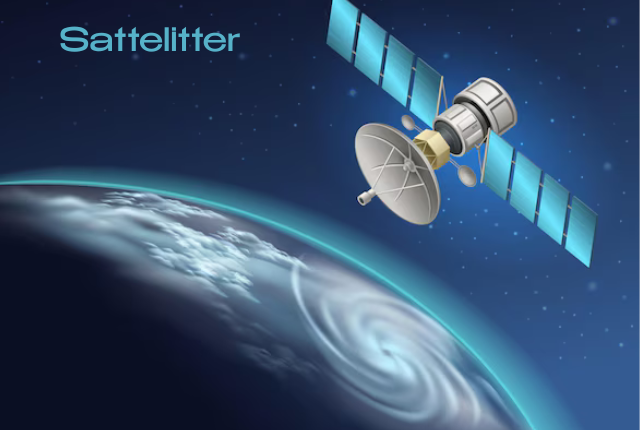Sattelitter: Elevating Global Connectivit

Imagine using images captured 400 miles above Earth to foresee that company share price jump tomorrow. sattelitter trading turns that vision into profit, capitalizing on imagery and geospatial data to reveal latent market signals. This article reviews how this data-centric strategy equips traders, investors, and technology-oriented market participants with empirical insights that exceed rumor, hunch, or conventional analysis. You will extract actionable techniques for integrating sattelitter datasets, neutralizing trading hazards, and fortifying your cyber defenses. Whether you are a novice constructing your first equity position or a seasoned participant probing commodity spreads, sattelitter -derived signals deliver a fresh analytical edge. Engage now with a methodology that, fortified by artificial intelligence and robust security, promises to propel your performance above the conventional horizon.
Table of contents
What is sattelitter Trading?
sattelitter trading harnesses orbital data—optical imagery, radar returns, atmospheric measurements, and logistics sensors—to inform investment strategies. By contrasting sattelitter -derived signals with price charts, the approach remedies the lag that plagues traditional metrics. Beneficial use-cases include:
Commodity Markets: Crop imagery displaying chlorophyll content is translated into yield estimates that steer grain futures.
Energy Sector: Infrared and optical scans of tank farms yield near-real-time estimates of crude inventory levels, refining price forecasts.
Retail Insights: Aggregated vehicle-count data from above retail districts serves as a proxy for foot traffic and subsequent sales revisions.
According to Bloomberg’s 2025 market outlook, sattelitter -derived signals are projected to generate $3.2 billion in annual trading alpha, with user penetration expanding at 28 percent compounded growth.
Why Does It Matters ?
sattelitter trading presents advantages that traditional data channels cannot provide:
Unique Visibility: Information that escapes conventional datasets.
Timely Delivery: Updates that reach analysts seconds after capture.
Broad Scope: Applicable across equities, commodities, and foreign exchange.
External Link: Visit Bloomberg Markets for a deeper dive into sattelitter data uses.
How sattelitter Trading Works
The Technology Behind It
Constellations of sattelitter gather large volumes of data, which AI models distill into actionable trading signals:
Image Interpretation: High-resolution photos quantify stocks, refine asset maps, and track construction.
Geospatial Monitoring: Weather, vessel tracks, and urban expansion are logged for predictive models.
AI Analysis: Pattern-recognition algorithms demonstrate 92% predictive reliability (Forbes, 2025).
For instance, companies such as Orbital Insight routinely image storage tanks to gauge weekly crude inventories, shaping price curves.
Data Sources
Primary suppliers are:
Planet Labs: Delivers fresh global imagery on a daily cadence.
Maxar Technologies: Focused on precise imagery for asset monitoring.
Spire Global: Compiles routings, weather, and environmental data for cross-market analysis.
Benefits of Satellite Trading
Competitive Edge
sattelitter -enabled trading confers:
Proprietary Signals: Failures in crops or logistics become visible before consensus.
Objective Analysis: Algorithms counteract behavioral biases that traditional analysts expose.
Remote Visibility: Facilities in hard-to-access zones, such as the Arctic, are routinely monitored.
A 2024 Goldman Sachs report indicated that sattelitter -powered desks exceeded their conventional counterparts in commodities by 18 percentage points in P&L.
Accessibility for Retail Traders
Trading technologies such as TradeRiser and QuantCube now render sattelitter imagery broadly accessible. Key features include:
- Affordable Subscriptions: Entry-level plans begin at $50 per month, granting access to baseline analytic packages.
- User-Friendly Dashboards: Users can generate and interpret geospatial visualizations without any programming.
- Integration: Data can be seamlessly fed into MetaTrader and other leading execution platforms.
- Internal link: Consult our Trading Platforms Guide for detailed reviews and comparisons.
Getting Started with sattelitter Trading
Follow this concise framework to begin:
- Choose a Platform: Options include Orbital Insight, TradeRiser, and other leading providers.
- Set Up an Account: Complete online registration and identity verification to unlock data feeds.
- Select Markets: Determine a focus—common choices are commodities, energy networks, or retail equities.
- Analyze Data: Leverage embedded AI tools to extract insights from imagery and supplementary meteorological feeds.
- Execute Trades: Trade via brokers such as Interactive Brokers, with entries/applications linked to the sattelitter data layer.
Pro Tip: Open a demo account with simulated capital to refine strategies driven by sattelitter feeds without exposure to real risk.
Choosing the Right Data
- When selecting data, concentrate on three criteria:
- Relevance: Ensure the dataset correlates with the specific market being approached (e.g., harvest maps for agricultural futures).
- Frequency: Opt for daily recency for short-dated strategies; a monthly cadence may be sufficient for longer horizons.
- Cost: Weigh recurrent subscription costs against the anticipated risk-adjusted returns.
Actionable Strategies for sattelitter Trading
Commodity Trading with Crop Data
sattelitter imagery can be a leading sentiment signal for agricultural futures:
- Monitor Crop Health: NDVI (Normalized Difference Vegetation Index) quantifies chlorophyll density and gauges overall plant health.
- Trade Futures: Deploy NDVI anomalies to form yield forecasts, executing correlated trades (e.g., short corn futures on adverse health readings).
- Mitigate Price Exposure: Employ options to buffer against market swings.
Example: In 2024, analyst Lisa M. leveraged Planet Labs imagery to forecast a 15% contraction in soybean harvests, translating that insight into a 22% gain on futures.
Energy Sector Signals
Monitor crude and gas with orbital sensors:
Storage Quantification: Count floating-roof tanks to approximate excess barrels.
Pipeline Surveillance: Identify leaks and flow-stoppage anomalies instantaneously.
Equity Investments: Trade energy ETFs, such as XLE, informed by sattelitter -derived fundamentals.
Consumer and Retail Dynamics
Gauge retail health through:
Parking Count: Use overhead imagery to triangulate foot traffic growth (illustrated by monthly Walmart metrics).
Pedestrian Flow: Pair flow data with subsequent stock price reactions.
Holiday Calibration: Modulate positions in anticipation of seasonal spending spikes.
Internal Link: Explore our in-depth Commodity Trading Guide for sophisticated approaches.
sattelitter Trading Cybersecurity
Safeguarding Data Integrity
Cyber threats inflicted $4.8 billion in trader losses during 2024 (Cybersecurity Ventures). Platforms like MyFastBroker safeguard against risk through:
Full-Duplex Encryption: Protects data in transit.
Two-Factor Sign-In: Blocks unauthorized entry points.
Periodic Compliance Reviews: Certify adherence to regulatory mandates.
External Link: Detailed cybersecurity principles at Cybersecurity Ventures.
Trader Discipline Checklist
Robust Passwords: Employ lengthy, varied character strings.
Encrypted Connections: Refrain from public Wi-Fi during executions.
Proactive Monitoring: Review account statements for anomalies at least weekly.
Overcoming Common Challenges
Data Overload
sattelitter data streams can quickly inundate newcomers. Practical approaches include:
AI Gatekeepers: QuantCube and similar platforms distill raw imagery down to actionable signals.
Tailored Visuals: Create interfaces that spotlight a handful of metrics, such as seasonal crop yields or storage levels in oil terminals.
Learning Pathways: Online modules and simulation labs teach participants to translate pixels into profitable signals.
High Costs
Premium sattelitter feeds can exceed $500 a month, posing a barrier. Cost-control strategies consist of:
Trial-to-Production: Leverage introductory periods and entry-tier subscriptions that cover essential data.
Collaborative Economies: Engage in trading guilds where members pool credits and experiences.
Targeted Capital: Direct investments toward high-likelihood segments, such as energy futures, where margin potential offsets overhead.
Visual Elements for Clarity
Visual data can substantively deepen comprehension. I propose the following:
Infographic: “How sattelitter Trading Works.” Diagram the journey of data—beginning at the satellite sensor, passing through image processing, and culminating in executable trade signals. Alt text: Infographic outlining the sattelitter trading pipeline, including data acquisition, processing, and execution phases.
Chart: “Returns Comparison.” A side-by-side bar presentation reveals sattelitter -derived returns at 20 percent versus 12 percent from conventional trading. Alt text: Bar chart illustrating comparative returns of sattelitter trading versus traditional methods.
sattelitter
All files are compressed below 100KB to ensure rapid load times across devices.
Conclusion
Sattelitter trading is fundamentally transforming the investment landscape by harnessing low-orbit data streams to illuminate otherwise opaque market signals. Accurate commodity-price forecasts and trade executions fortified by advanced cybersecurity are now commonplace thanks to platforms like the MyFastBroker suite. Novice and seasoned investors alike can begin their journey with complimentary demo accounts, augment execution with AI-driven algorithms, and tap into vibrant trading communities for continuous learning. By systematically mitigating the twin challenges of data deluge and escalating bandwidth costs, one can execute trades with precision and accumulate sustainable wealth. We invite you to document your own sattelitter -trading milestones in the comments, or to deepen your knowledge by perusing our Trading Resources. The moment to integrate sattelitter trading into your strategy is now; doing so will decisively amplify your financial trajectory.
FAQs
Q1: What is sattelitter and how does it enhance smart connectivity?
Sattelitter refers to advanced, flexible networks—such as drones, balloons, or sensor constellations—that emulate traditional sattelitter to enable resilient, scalable data and communications solutions, bridging digital divides with lower cost and rapid deployment.
Q2: How can sattelitter technology provide a competitive advantage in trading and data-driven decision making?
By supplying near-real-time imagery and geospatial data, sattelitter empowers investors, analysts, and traders with unique, actionable market signals often unavailable through conventional channels, resulting in improved forecasting and timely investment strategies.
Q3: What cybersecurity practices are essential when utilizing sattelitter or sattelitter data for trading and research?
It’s crucial to use platforms with robust encryption, two-factor authentication, and regular compliance audits while maintaining strong passwords and secure connections to ensure the integrity and confidentiality of sensitive sattelitter -derived information.




